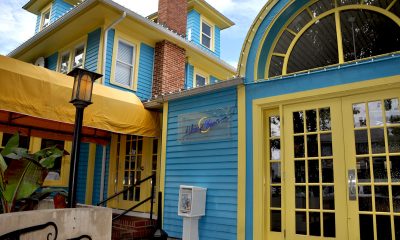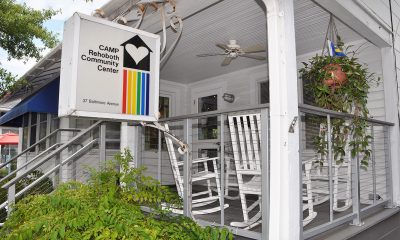a&e features
Happy 25th, CAMP Rehoboth
Community center founded by gay couple that met at White House
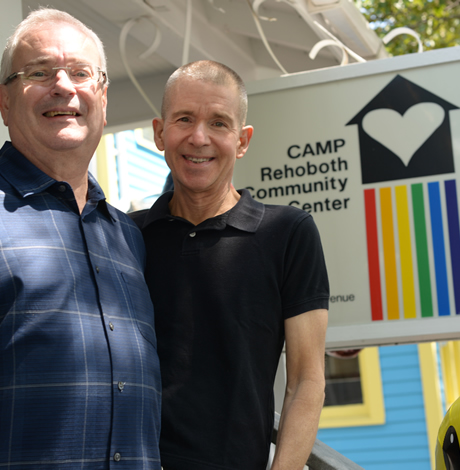
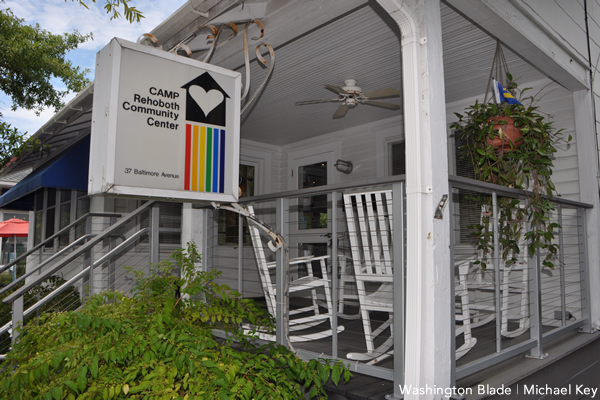
CAMP Rehoboth serves the local LGBT community in and around the popular beach resort. (Washington Blade photo by Michael Key)
Silver Gala
Friday, Oct. 9, 7-11 p.m.
Nassau Valley Vineyards
Tickets start at $100
Silver Block Party
Sunday, Oct. 11, 12-4 p.m.
Baltimore Avenue, 2nd block
Suggested donation $10
REHOBOTH BEACH, Del. — As it celebrates its 25th anniversary this weekend, CAMP Rehoboth, the LGBT community center and community services group here, is continuing its role as a well-known and highly regarded operation in Delaware and in the Mid-Atlantic region.
Before Steve Elkins and Murray Archibald, who have been a couple for 37 years, moved to Rehoboth Beach in October 1990 and founded CAMP Rehoboth less than one year later they had been vacationing there since the summer of 1981.
Like the large number of other LGBT people who began to flock to the Delaware beach resort town in the 1970s the two noticed that at least some longtime, year-round residents had become uncomfortable as Rehoboth became increasingly known as a gay destination.
According to Archibald, he and Elkins along with some of their friends sensed the need for an LGBT support and advocacy group in the town around 1989 or 1990. That’s when the Rehoboth Beach Homeowners Association produced and circulated a bumper sticker that said, “Keep Rehoboth A Family Town.”
Everyone knew that message was aimed at the town’s LGBT visitors and growing number of LGBT residents, implying if not saying so openly, that they were not welcome, Archibald and Elkins told the Washington Blade.
“And I always said we wanted it to be a family town as well but families come in all sizes, shapes and orientations,” Elkins said.
Following a series of meetings in late 1990, Elkins and Archibald in 1991 launched CAMP Rehoboth, the town’s first LGBT advocacy and civic organization whose name was an acronym for ‘Create a More Positive’ Rehoboth.
“We thought everybody was focusing on the negative and we said, ‘Let’s create a more positive Rehoboth,’” said Elkins in reflecting on the group’s and the town’s evolution in gay-straight relations since that time.
Archibald said in addition to concerns over the hostile message from the bumper sticker, the atmosphere for gay men in the late ‘80s and early ‘90s was still being shaped by the AIDS epidemic, and he and Elkins thought an LGBT organization would provide support services on that front.
“We were just coming out of that period where so many people were dying and were still dying,” said Archibald. “We were fighting some resistance in town against so many gay people coming to town,” he said. “And you knew we needed something.”
In its first two years, the then all-volunteer group operated in a small rented space on Baltimore Avenue in downtown Rehoboth located two blocks from the boardwalk and beach. The fledgling group had a budget of about $40,000 from money that it managed to raise among early supporters.
It currently has a budget of just under $1 million, with anticipated revenue of $1.1 million for 2015. It has a staff of five full-time paid employees, including Elkins, who serves as executive director. The group’s website proudly says there are three full-time, unpaid volunteer staff members, including Archibald, who play a key role in its operations.
Since 1993, Archibald has served as president of the CAMP Rehoboth Board of Directors. He also serves as producer of the group’s annual Sundance fundraising benefit and as creative director for the CAMP Rehoboth Community Center and for Letters from CAMP Rehoboth.
“Letters,” as many call it, serves as the group’s newsletter-magazine that comes out twice monthly during the summer season and once a month during the off season. The publication is filled with ads from dozens of local businesses, turning it into an important source of revenue supporting CAMP Rehoboth’s multitude of programs and activities.
The ad revenue from Letters; a separate stream of revenue from more than 800 paid members/supporters, which generates about $240,000 annually; and money raised by fundraising events such as Sundance helped the group purchase a complex of several small and larger buildings at the site where it first rented space in 1990.
The successful revenue generating efforts also helped to fund construction of the CAMP Rehoboth Community Center, which now occupies the largest building on the site and the attractively designed courtyard that lies between two larger buildings. The building across the courtyard from the main CAMP Rehoboth building and community center is occupied by a home furnishing and interior design gallery and shop, which rents the space from CAMP Rehoboth, generating further revenue.
Similarly, a small financial services firm and the lesbian-owned Lori’s Café, which occupy small annex buildings located in the rear of the courtyard, also rent their space from CAMP Rehoboth.
Adding yet another stream of revenue is the community center’s “big” room, which can serve as a catering hall or auditorium with a seating capacity of about 90, and several smaller meeting rooms, all of which are available for rent. Archibald said the “big” room is regularly rented to same-sex couples for their wedding receptions.
Among CAMP Rehoboth’s largest programs is CAMPsafe, which for close to 20 years has provided HIV prevention related services, including HIV testing and counseling. Archibald said that although it has catered mostly to gay and bisexual men in the Rehoboth area and eastern Sussex County everyone is welcome to come in for its services.
In recent years the program has expanded under a $120,000 contract from the state health department to include testing for other sexually transmitted infections (STIs).
“We do it for gonorrhea, chlamydia and we have just been selected for doing the first rapid test for syphilis in the state of Delaware,” Elkins said. “That will start in January.”
The CAMPsafe program along with a general mental health counseling program is directed by Salvatore Seeley, a licensed clinical social worker with a Ph.D. in sexual health counseling, Elkins said. Under Seeley’s direction, the counseling program usually involves up to six counseling sessions for any individual client after which Seeley refers them to a clinical therapist if needed.
Seeley’s reputation as a trusted counselor in a wide range of areas, including sexual health and couple counseling, has spread throughout the Sussex County area and even straight couples sometimes drop in, said Elkins.
“Occasionally it’s a straight couple – a husband or wife – where one spouse comes out and he counsels them on that,” Elkins said. “It runs the full gamut.”
Another program is the CAMP Rehoboth Chorus, which has close to 90 members and performs at venues in Rehoboth and surrounding areas, including nursing homes and community events.
Elkins serves as head of a longstanding CAMP Rehoboth program that provides LGBT-related sensitivity training for Rehoboth police officers and state park police officers assigned to the Rehoboth area. Among other things, Elkins said the trainings have resulted in improved relations with police.
Some of the other programs, all of which are listed on the site camprehoboth.com, include a women’s golf league; gallery and performance space for artists; advocacy for and education of local residents, visitors and businesses on LGBT issues; grief counseling; public WiFi access; an annual women’s conference and women’s weekend; and promotion of non-profit local LGBT and general community events.
Archibald noted that as CAMP Rehoboth’s visibility increased over the past 25 years, some in the LGBT community called for it to become more activist and aggressive in its advocacy work similar to the model of the 1980s-era AIDS direct action group ACT UP. He said he and Elkins and the original corps of supporters chose not go in that direction, instead choosing a more conciliatory path.
To this day, the group’s mission statement published in each issue of Letters says, among other things, “We seek to promote cooperation and understanding among all people, as we work to build safe, inclusive communities with room for all.”
Elkins said he believes that approach has succeeded, helping to make Rehoboth Beach a welcoming place for LGBT people that continues to attract LGBT tourists and new residents to the town.
“The thing I’ve always said is once we actually started talking to one another we all realized that we had the same desire – and that’s to have a safe and inclusive community,” Elkins said. “And once we started talking about what we had in common we find we have a lot more in common than we have difference.”
Elkins’ and Archibald’s journey that eventually led them to the founding of CAMP Rehoboth began in Washington, D.C., when the two met on Sept. 18, 1978, and soon fell in love, as Elkins tells it.
Elkins had been working as a White House administrator during the Carter administration and Archibald, an artist and painter, was helping a friend in Washington deliver a painting to Elkins’ office in the Old Executive Office Building, which is part of the White House grounds.
“She called and Steve cleared us all in,” Archibald recalls. “And she said we have to go get another one and he said well Murray’s going to stay here and I’m going to give him a tour of the White House. It was all part of the compound, and he walked me right into the Oval Office that day,” said Archibald.
“And that was it. From that time on it was the two of us,” he said.
When Carter left the White House after losing his re-election bid in 1980 to Ronald Reagan, Elkins, whose job was a political appointment, took a new job as sales manager at a computer company in New York City, where he and Archibald moved. After losing that job in the 1990s when his company went bankrupt, Elkins and Archibald decided to move permanently to Rehoboth Beach, where Elkins became general manager for the Strand nightclub.
In 1993, two years after he and Archibald founded CAMP Rehoboth and served on its board as volunteers, the board asked Elkins to become the group’s first paid executive director, and he accepted. That set in motion a 25-year journey for him and Archibald that has placed them largely at the center of CAMP Rehoboth’s whirlwind of activities today.
Kristen Minor, now 33, was 13 when she first began grappling with the realization that she might be a lesbian and ventured into CAMP Rehoboth 20 years ago and was greeted by Archibald, she writes in a column in the current issue of Letters. She tells of how she first met Archibald and Elkins at the church she and her family attended in Rehoboth and how CAMP Rehoboth became a refuge for her at a time when she “navigated the terrors of middle and high school” and was able to meet a “handful” of other LGBT teenagers.
“The influence of a community organization is sometime hard to measure,” she wrote. “I don’t know how to measure that CAMP saved my life and the lives of many of my friends; it was our real life ‘It Gets Better’ campaign far before such a thing ever existed.”
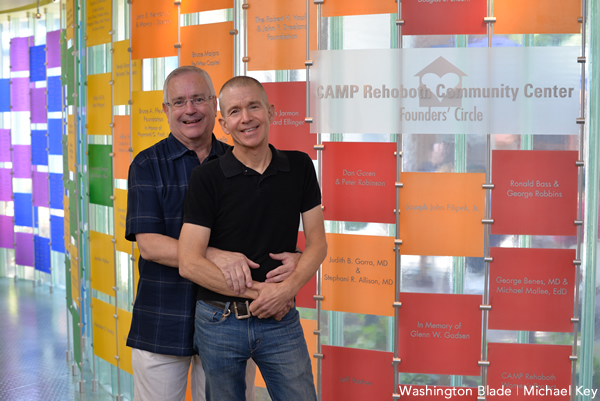
Steve Elkins, left, and Murray Archibald of Camp Rehoboth are gearing up for a busy October celebrating the community center’s 25 years. (Washington Blade photo by Michael Key)
a&e features
Local, last-minute holiday gift ideas
Celebrate the season while supporting area businesses

The DowntownDC Holiday Market is bustling. Union Station is decked out with its annual Christmas tree. Washingtonians have wrapped their houses and apartment balconies with festive lights and holiday decorations. The holiday season is here. And with stockings to fill and empty space under the tree, Washington’s local shops and artists have plenty to offer.
Show your LGBTQ and D.C. pride with the Washington Blade’s annual holiday gift guide.
To embrace the holiday buzz: The Blanco Nwèl cocktail from Alchy Cocktails. This Caribbean eggnog is one of Alchy Cocktail’s seasonal holiday cocktails. The flavor profile is similar to coquito, a traditional Puerto Rican Christmas drink with a coconut base. As a queer and Caribbean-owned business, Alchy Cocktails has been based out of Washington since 2021. Blanco Nwèl is available in both cocktail ($24) and mocktail ($12) online and at a variety of holiday markets, including the Tingey Plaza Holiday Market, the Flea Market at Eastern Market, Union Station’s Main Hall Holiday Market, and more. ($24)
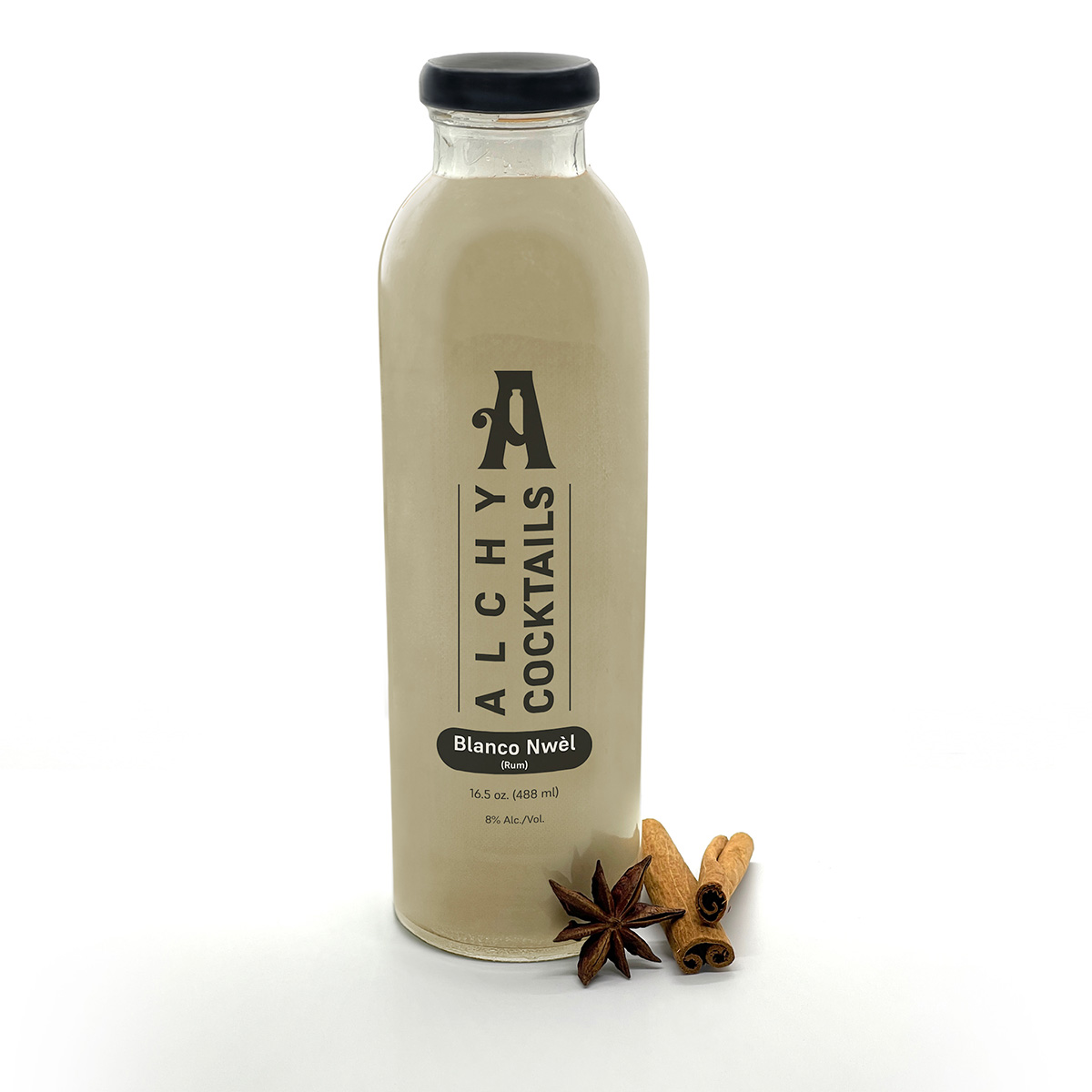
A spicy bite: Gordy’s Cajun Okra from Salt and Sundry. These spicy, tangy pickles pull on Southern Cajun-style flavors, packing a punch with paprika, cayenne, and more. Gordy’s is an LGBTQ-owned and Washington-based brand, making this gift an opportunity to support a local LGBTQ business straight from the jar. This pantry staple is available on Salt & Sundry’s website and at its locations in Union Market, Logan Circle, and its Georgetown holiday pop-up store. ($14)


To celebrate Washington pride: The DC Landmark Tote Bag from The Neighborgoods. Native Washingtonians, visitors, friends and family alike will find something to love about this Washington-themed tote bag. Food trucks, the 9:30 Club, the Metro logo and pandas from the National Zoo are just some of the city’s landmarks depicted across the tote in a red, white, and blue color palette. The tote is a part of the DC Landmarks collection, which donates 10 percent of its sales to the American Civil Liberties Union. The Neighborgoods itself is a local, woman-owned business built out of a passion for screen-printing in 2013. The 100 percent cotton canvas tote is for sale online or at the DowntownDC Holiday Market. ($22)
To give friends and family their flowers: The Flowers Bandana from All Very Goods. This 100 percent cotton bandana was designed in Washington and hand printed in India. Its uniqueness comes in being covered with the faces of Black women, representing a “love letter to all women but especially Black women,” according to All Very Goods. The Black woman-owned and operated business, based out of Northwest Washington, has a mission to celebrate diversity and representation through its products. The bandana intends to give Black women their “flowers.” The Flowers bandana is available for purchase online. ($24)

To unlock culinary creativity: The Curious Chef Gift Collection from Each Peach Market. This customizable collection of kitchen oddities — ranging from tinned fish to chili oil — is a quirky gift for the most inventive chefs. The collection is available in a Standard Santa, Extra Goodies and Super Holiday Size for up to $165. The Washington-based market, founded in 2013, permits customers to make the collection special by specifying what unique ingredients are packaged, including products made by local or LGBTQ brands. Each Peach Market offers assembly and pick up in-person at its Mount Pleasant shop and also offers local delivery and nationwide shipping via its website. ($85)

To give a touch of sweetness: The DC Landmark Chocolate Covered Oreo Holiday Cookies from Capital Candy Jar. Wrapped in a festive red bow, this box of nine cookies embraces love for Washington and the holiday season in one. Among the dark and milk chocolate covered cookies are images of the U.S. Capitol, the White House, the Lincoln Memorial, the Jefferson Memorial and festive hollies. The treat, packaged in a Hill East facility just a few blocks from the Capitol, is available for purchase online and at the DowntownDC Holiday Market. ($23.95)


To celebrate queer gaming: Thirsty Sword Lesbians from Labyrinth Games & Puzzles. This roleplaying game embraces lesbian culture by unlocking a world of swords, romance, and battle. Ideal for group settings, the book presents a system of world building and character identities that are best brought to life by creative minds. Labyrinth, which has been a local Washington business for more than 15 years, celebrates non-digital fun through games and puzzles that connect the community. This gift is offered online and at Labyrinth’s Capitol Hill location. ($29.99)
To make a bold statement: The “Resist” T-shirt from Propper Topper. This locally screen-printed black tee features the Washington flag designed within a raised fist, symbolizing both Washington pride, and political resistance. The shirt is made exclusively by Propper Topper, a local Washington business that evolved from a hat shop to a gift store since opening in 1990. The tri-blend unisex shirt is available both for pickup at Propper Topper’s Cathedral Heights location and shipping via the online site. ($32)

To keep it c(g)lassy: The Glass Ball earrings from Blue Moon Aquarius. Gifting can rarely go wrong when it comes to a new pair of earrings. The unique statement earrings — made of polymer clay, glass, and 18k gold plating over surgical steel — are hand cut, sanded and assembled in Washington, meaning each set is unique. Blue Moon Aquarius, a local brand, is known for its small batch jewelry and home decor designed with clay materials. Available in oxblood, hunter green, lavender, and bluestone color palettes, these earrings are available for purchase on Blue Moon Aquarius’ website and at the DowntownDC Holiday Market. ($48)
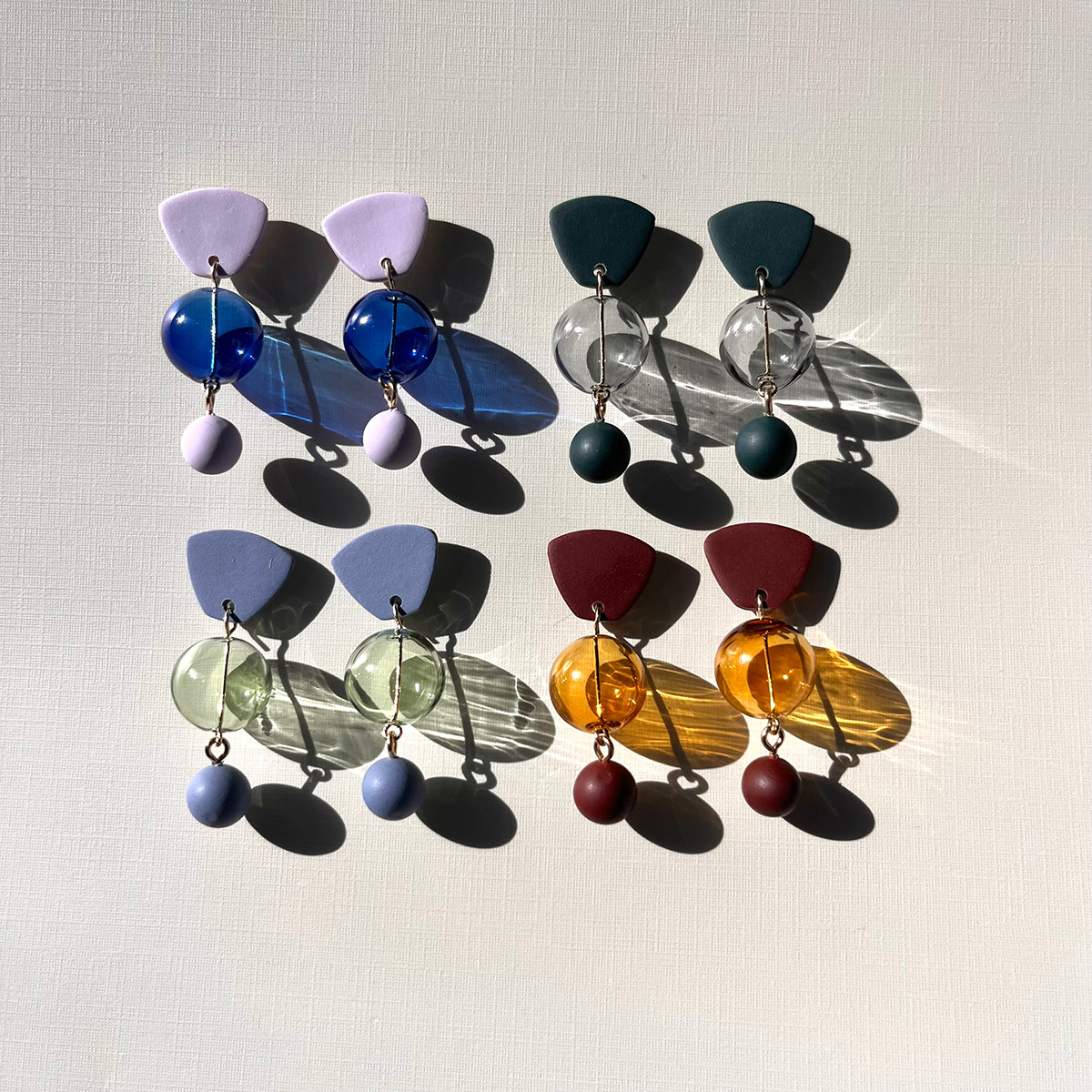
To elevate a holiday tea or charcuterie party: The Honey Flight: Tea Lover’s Selection from BannerBee. This local honey company presents the ideal gift to make cozying up with a cup of tea slightly more special. The Honey Flight contains three types of raw wildflower honey infused with fair trade Ugandan vanilla bean, chai spices, and locally sourced lemon thyme herb. The gift is also an opportunity to uplift a family company based in the Mid-Atlantic that offers all-natural, sustainable products. The flight is available online, at the DowntownDC Holiday Market or at the Arlington Courthouse and Dupont Farmers’ Markets. ($36)
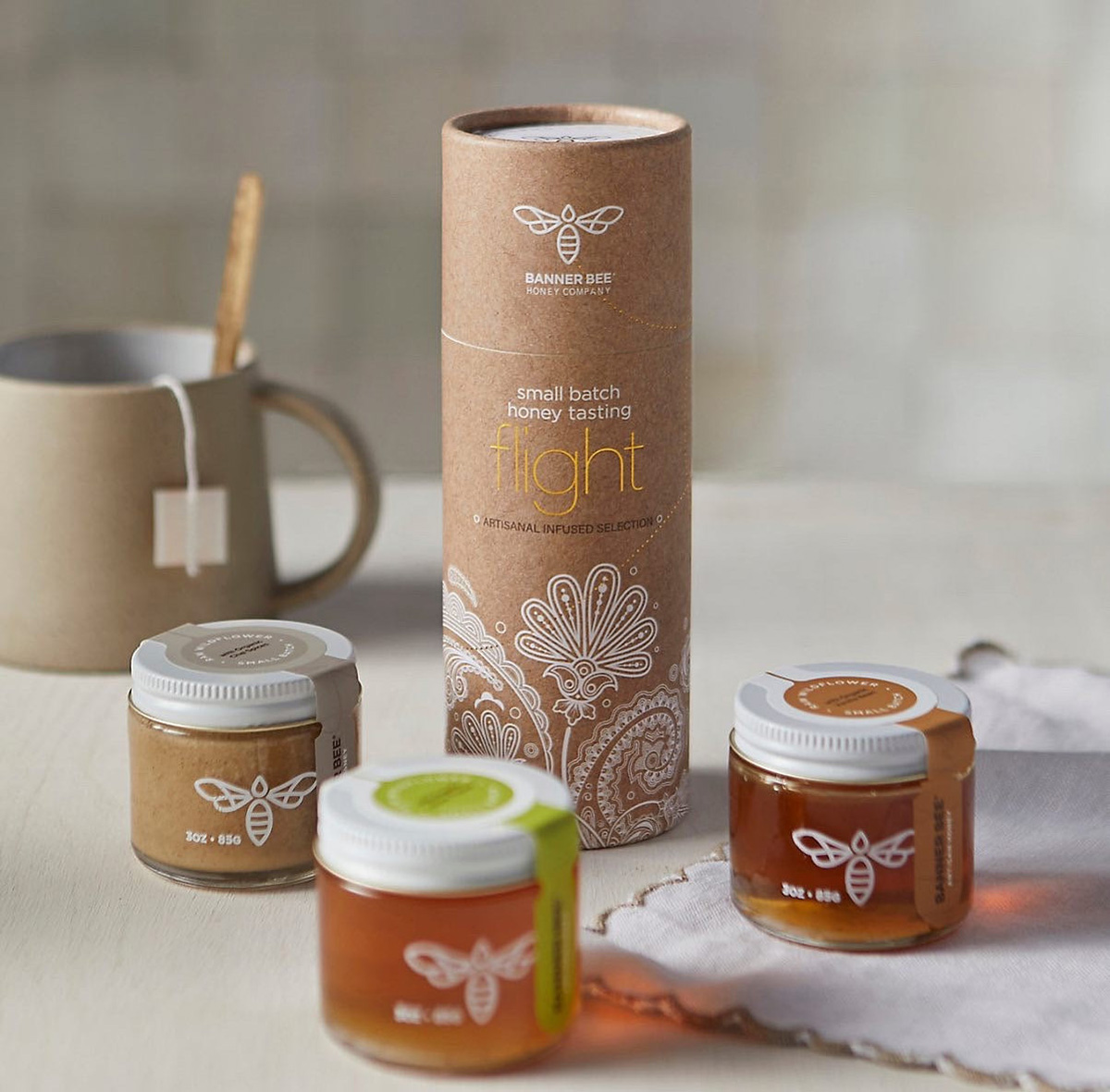
For Baltimore shoppers: If you’re in Charm City, don’t miss Balston Mercantile, opened by a gay couple in June. Their gorgeous shop in the Hampden neighborhood offers an array of unique, upscale finds, from barware and artwork to cookbooks and home decor and more. (849 W. 36th St.)
a&e features
Have yourself a merry John Waters Christmas
Annual holiday show returns to Alexandria and Baltimore
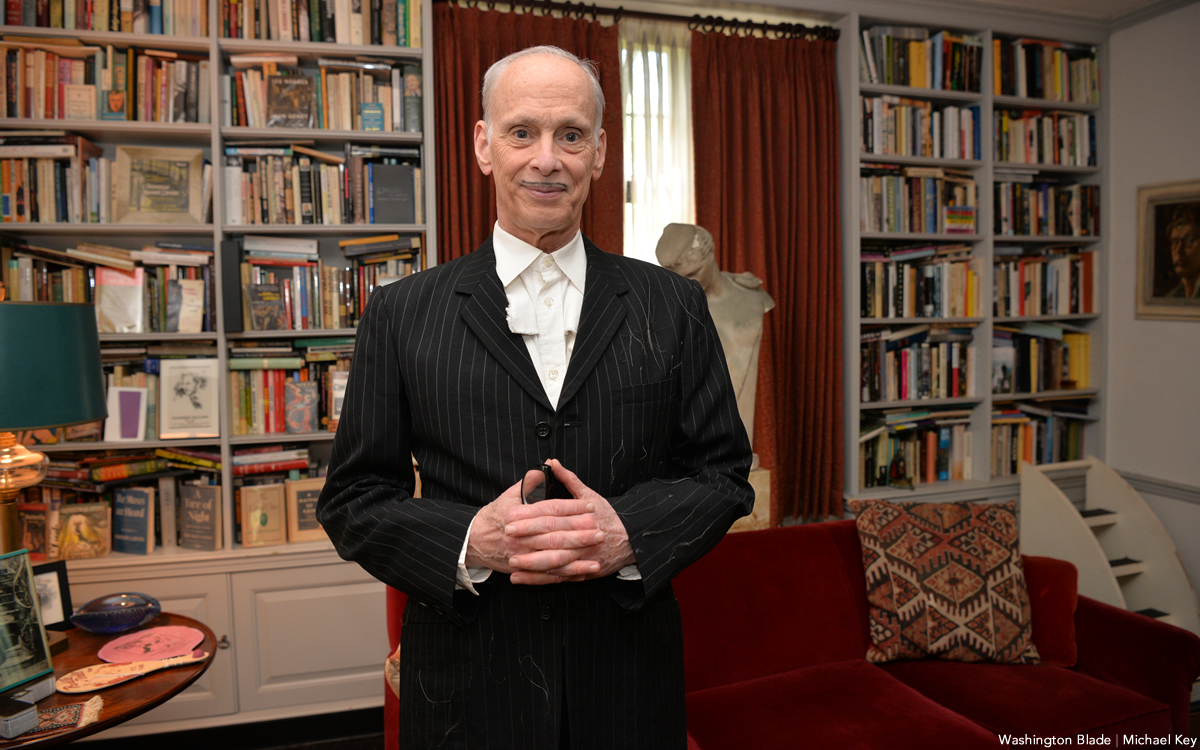
When it comes to iconic Christmas scenes in movies, none can top the tree-toppling tantrum thrown by cha-cha heels-deprived Dawn Davenport in John Waters’s fifth full-length feature “Female Trouble” from 1974. Therefore, it’s not surprising that Waters continues to make art out of Christmas, performing his spoken word Christmas tour in cities across the country. Waters has even more reason to celebrate with the release of his new red vinyl 7” single, a cover of Little Cindy’s “Happy Birthday Jesus (A Child’s Prayer)” on the A-side, and “A Pig Latin Visit From St. Nicholas” on the B-side. If you’re still looking for unique Christmas gifts, consider this record. As always, John was kind enough to make time for an interview in advance of his tour dates.
BLADE: John, in preparation for this interview with you, I went back and listened to Little Cindy’s original rendition of “Happy Birthday Jesus (A Child’s Prayer)” on your “A John Waters Christmas” CD.
JOHN WATERS: One thing I did, if you notice, I make the same stumble in my recording that she did in the original.
BLADE: It sounded to me like she got choked up.
WATERS: No, I think she just stumbles over a word, so I stumbled over the same word. It’s appropriation, insanely.
BLADE: Is this a song you first became aware of in your youth or when you were an adult?
WATERS: When I was doing the Christmas album, I had this friend named Larry Benicewicz. He was kind of my idea man with music. He knew every single old record. I would say to him, “Weird Christmas songs,” when we were doing a soundtrack, or a song about bears, or a song about this, and he would give me all these tapes. It was one of the ones he played for me. A lot of the songs I put in my movies and on my records, I did know as a kid. I did not know this one, but I immediately embraced it. I don’t think it’s campy. I think it really is spiritual in a weird way. My doing it makes it a novelty record. I am really for novelty records, and there aren’t any anymore. Why was there not a COVID novelty record? That’s insane. The dance “The Bug” that’s on the “Hairspray” soundtrack would be perfect for COVID.
BLADE: The thing that struck me was that for a Christmas song in the voice of a child, a kind of death pall hangs over it, with lines like, “If I was good you’d let me live with you” and “they nailed you to the cross, they wanted you to die.”
WATERS: All of it! When I see children at midnight mass kneeling in front of a nude man nailed to a cross, I feel like I’m at The Eagle! It is S&M, it’s creepy. I took the same cover (photo) from her record to parody and put my face on it. The same thing I did with The Singing Dogs last year when I covered (their version of) “Jingle Bells.” I’m really into novelty records. I love them and I’m trying to bring them back. I don’t expect anybody to ever play these records. Even The Singing Dogs one said on it, “Please do not play this record” [laughs]. And the flipside, the Pig Latin version, is almost impossible to listen to.
BLADE: I’m so glad you mentioned that. “A Pig Latin Visit From St. Nicholas” reminded me of the lost art of speaking in Pig Latin. I also recall watching the PBS series “Zoom” as an adolescent and learning to speak “ubbi dubbi,” a distant relative of Pig Latin. Do you think that the time is right for a Pig Latin or ubbi dubbi revival?
WATERS: Here’s the thing, I never could pick up any language, except Pig Latin. I’ve been in every foreign country. Foreign countries have given me money to learn to speak the language. I can never do it! But Pig Latin…my parents and other parents in the ‘50s spoke Pig Latin so kids couldn’t understand what they were saying. Then my mother taught it to me, and I used it. The hardest take to shoot in “Pink Flamingos” was not eating the dog shit. It was when the cast skipped, in one take, saying “E-way, are-yay e-they ilthiest-fay eople-pay in-hay e-they ole-hay ide-way orld-way.” We’re the filthiest people in the whole wide world in Pig Latin. We had to do so many takes so they could do it once without screwing it up. In “Polyester,” Edith (Massey) answers the phone, “ello-hay.” I did a photo piece where it was all subtitled in Pig Latin. Like “osebud-Ray” (from “Citizen Kane”) or in “Streetcar,” “ella-Stay!” [Laughs] All the iconic dialogue translated into Pig Latin. My assistant who helped me do it, had never heard of Pig Latin. She really got good at it because she lived in many foreign countries and can pick up languages. But it’s not that easy to do it correctly and read it. Your computer will translate into Pig Latin.
BLADE: AI understands Pig Latin?
WATERS: I guess that’s AI. It wasn’t 100% right, but it was close. I can speak it if I look at it, but just do a bit at a time. It was a challenge that no one would possibly care about or want to do.
BLADE: I think you pulled it off very well.
WATERS: If you want people to leave on Christmas morning, you put it on. That’s how you get your guests to leave. It’s time to go.
BLADE: Ood-gay i-bay! How did your relationship with record label Sub Pop, which released 2021, 2022, 2024, and new 2025 holiday singles, come about?
WATERS: I believe the first thing I did for them was “Prayer to Pasolini.” They came to me through Ian Brennan. He’s won a couple Grammys for World Music, but he is also is one of my agents who does the Christmas tour and a lot of my shows, anything with music. He helped me arrange each one of the songs. He had a relationship with Sub Pop. It was perfect. My friends in Baltimore, (the band) Beach House, have had huge success.
BLADE: That’s right, they’re on Sub Pop!
WATERS: Yes! I’m happy to be on it. I’ve even been to the warehouse and posed for pictures like Jackie Suzanne used to do.
BLADE: Is there any chance that “A John Waters Christmas” might be reissued on vinyl by Sub Pop?
WATERS: No. It’s such a nightmare to get the rights and to renew them. You have to find the publisher and the writer, and they usually hate each other. It doesn’t matter if it’s obscure or famous, it’s hard to get. You have to make the deal. The singer doesn’t get anything unless they play it on the radio. It would be so complicated legally, and there would be such a [laughs] tiny audience for it. I hope it will come out again. The same thing with the one for Valentine’s Day. I had two of them that did quite well when they came out; “A Date With John Waters and “A John Waters Christmas.” The “John Waters Christmas” album is still the soundtrack that plays whenever I’m doing my spoken word Christmas show as people are entering the theater.
BLADE: Aside from your annual Christmas show tour, what else do you do for the holidays now, and are there any traditions that you’ve carried over from your family?
WATERS: Certainly! I have two sisters, my brother’s widow, and me, so there are four and we take turns each year to have the Christmas dinner. Mine was last year. An entire sit-down dinner. Mom’s China, the silverware, the entire full dinner. It’s pretty traditional. I don’t have a Christmas tree, but I do decorate the electric chair from “Female Trouble.” That is a tradition in my family. We do have Christmas decorations, but they’re usually weird ones that fans sent me. I have one with Divine knocking over the Christmas tree, and the Christmas tree lights up, all sorts of amazing things. There is definitely a tradition here that might be a little altered, but it is definitely a tradition. I used to have a giant party every year, but COVID ended that. I still wouldn’t want 200 people in my house breathing right now.
BLADE: I was looking at your tour schedule and wondered if there are any new cities in which you’ve never performed the John Waters Christmas show that have been added to this year’s schedule?
WATERS: I don’t think there’s a city in America in which I haven’t done one show! The only places I haven’t been to are Hawaii and Alaska. I could do it there, but it’s too long on a tour. I can’t think of a city I haven’t played in in America over the last 50 years. The Christmas show is completely different every year. It doesn’t matter if you saw it last year.

Some gifts scream practical, others whisper luxury, and a few flat-out blur the lines. From cocoa that feels ceremonial to a cologne that linger like a suggestive smirk, this year’s ultimate gift picks prove that thoughtful (and occasionally naughty) presents don’t have to be prosaic. Welcome to your holiday cheat sheet for festive tangibles that get noticed, remembered, and maybe even result in a peck of gratitude planted under the mistletoe. Consensually, of course.
Amber Glass Champagne Flutes
Pop the champs – but make it vintage. These tulip-shaped stunners in amber-tinted glass bring all the Gatsby vibes without the Jazz-age drama. Whether you’re toasting a milestone or celebrating a Tuesday, their seven-ounce capacities and hand-wash-only care make ‘em as practical as they are pretty. Pair with a thoughtful bottle of bubs and gift with a glittering wink. $18, NantucketLooms.com
Disaster Playbook by Here Comes the Apocalypse
Because the end of the world shouldn’t be a solo act, this spiral-bound guide is your step-by-step roadmap to surviving and thriving when everything else goes sideways, which might be sooner than you think. Packed with checklists, drills, and a healthy dose of humor, it’s like a survival manual written by your most prepared (and slightly snarky) friend. Whether you’re prepping for a zombie apocalypse or, more realistically, REVOLUTION!, this playbook’s got your back. $40, HereComesTheApocalypse.com

Wickless Vulva Candles
Bold, luxurious, and completely flame-free, CTOAN’s wickless candles melt from beneath on a warmer, releasing subtle, sophisticated fragrances, like sandalwood or lavender. The vulva-shaped wax adds a playful, provocative element to any space –perfect for a bedroom, living room, or anywhere you want elegance with an edge. A gift that celebrates form, intimacy and self-expression, no fire required. $39, CTOANCO.com
Villeroy & Boch Royal Classic Christmas Collection
Every meal is a mini celebration – with whimsy at every place setting – in Villeroy & Boch’s Royal Classic festive dinnerware collection that hits all the right notes. Made from premium German porcelain, it features nostalgic little toys, nutcrackers, and rocking horses in delicate relief, giving your holiday spread a playful but refined twist. Dishwasher- and microwave-safe, it’s luxe without the fuss. Gift a piece to a special someone, or start a collection they’ll use (and show off) for years to come. $22-$363, Villeroy-Boch.com
Greenworks Electric Lawnmower
You a ’hood queen who considers lawn care performance art – or just wants to rule the cul-de-sac in quiet, emission-free glory? Greenworks’ zero-turn electric mower has the muscle of a 24-horsepower gas engine but none of the fumes, drama or maintenance. Six 60V batteries and a 42-inch deck mean you can mow up to two-and-a-half acres on a single charge – then plug in, recharge, and ride again. It’s whisper-quiet, slope-ready, and smooth enough to make you wonder why you ever pushed anything besides your queer agenda. The perfect gift for the homeowner who loves sustainability, symmetry, and showing off their freshly striped yard like that fresh fade you get on Fridays. $5,000, GreenworksTools.com
Molekule Air Purifier
For the friend who treats their space like a sanctuary (or just can’t stand sneezes), the Molekule Air Pro is magic in motion. Covering up to 1,000 square feet, it doesn’t just capture allergens, VOCs, and smoke – it destroys them, leaving your air feeling luxury-clean. FDA-cleared as a Class II medical device, it’s serious science disguised as modern design. Gift it to your city-dwelling, pet-loving, candle-burning friend who likes their living room as pristine as their Instagram feed. $1,015, Molekule.com

Cipriani Prosecco Gift Set
Effervescent with stone-fruit sweetness and a touch of Italian flair, the Cipriani Bellini & Prosecco gift set brings brunch-level glamour to any day of the week. The Bellini blends rich white-peach purée with sparkling wine, while the dry ’secco keeps things crisp and celebratory. Pop a bottle, pour a flute, and suddenly winter weeknights feel like a party – even with your pants off. $36, TotalWine.com
Woo(e)d Cologne
British GQ recently crowned Woo(e)d by ALTAIA the “Best Date Night Fragrance,” and honestly, they nailed it. Confident without being cocky – smoky gaïac and Atlas cedarwood grounds the room while supple leather and spicy cardamom do all the flirting – it’s a scent that lingers like good conversation and soft candlelight. Gift it to the one who always turns heads – or keep it for yourself and let them come to (and then on) you. $255, BeautyHabit.com

Lococo Cocoa Kit
Keep the run-of-the-mill mugs in the cabinet this Christmas and pull out Lococo’s handcrafted Oaxacan versions that demand you slow down and sip like it matters. Paired with a wooden scoop, rechargeable frother, and Lococo’s signature spice hot-chocolate blend (vegan, gluten-free, with adaptogenic mushrooms), this holiday kit turns Mexi-cocoa into a mini ritual you’ll look forward to. Perfect for anyone who loves a little indulgence with a side of ¡A huevo! energy.
Manta Sleep Mask
Total blackout, zero pressure on the eyes, and Bluetooth speakers built right into the straps, this ain’t your mama’s sleep mask — but it could be. The Manta SOUND sleep mask features C-shaped eye cups that block every hint of light while ultra-thin speakers deliver your favorite white noise, meditation, or late-night playlist straight to your ears. With 24-hour battery life, breathable fabric, and easy-to-adjust sound, it turns any bed (or airplane seat) into a five-star sleep suite. Perfect for anyone who treats shut-eye like an art form (or just wants to escape their roommate’s late-night bingin’ and/or bangin’). $159, MantaSleep.com

Shacklelock Necklace
Turn the industrial-chic vibe of a shackle into a sleek statement. Mi Tesoro’s platinum-plated stainless-steel necklace sits on an 18-inch wheat chain, featuring a shackle-style latch pendant that’s waterproof, tarnish-free, and totally fuss-les. Beyond style, it nods to a classic gesture in the queer leather community: replacing a traditional Master lock with something elegant to quietly signal belonging to someone special. Wear it solo for a minimalist edge or layer it like you mean it; either way this piece locks in both your look and your intentions. $90, MiTesoroJewelry.com
Parkside Flask Mojave Edition
Wine nights get a desert glow-up with Parkside’s limited-edition 750-milliliter all-in-one flask draped in sun-washed bronze and badland hues like sage, sand, and terracotta – with magnetic stemless tumblers that snap on for effortless shareability. It keeps your vino chilled for 24 hours, pours without drips (no tears for spilled rosé, please), and even lets you laser-engrave your own mantra or inside joke. Perfect for picnics, surprise rooftop clinks, or gifting to your favorite wine (or desert) rat. $149, HighCampFlasks.com

Mikey Rox is an award-winning journalist and LGBT lifestyle expert whose work has published in more than 100 outlets across the world. Connect with him on Instagram @mikeyroxtravels.

